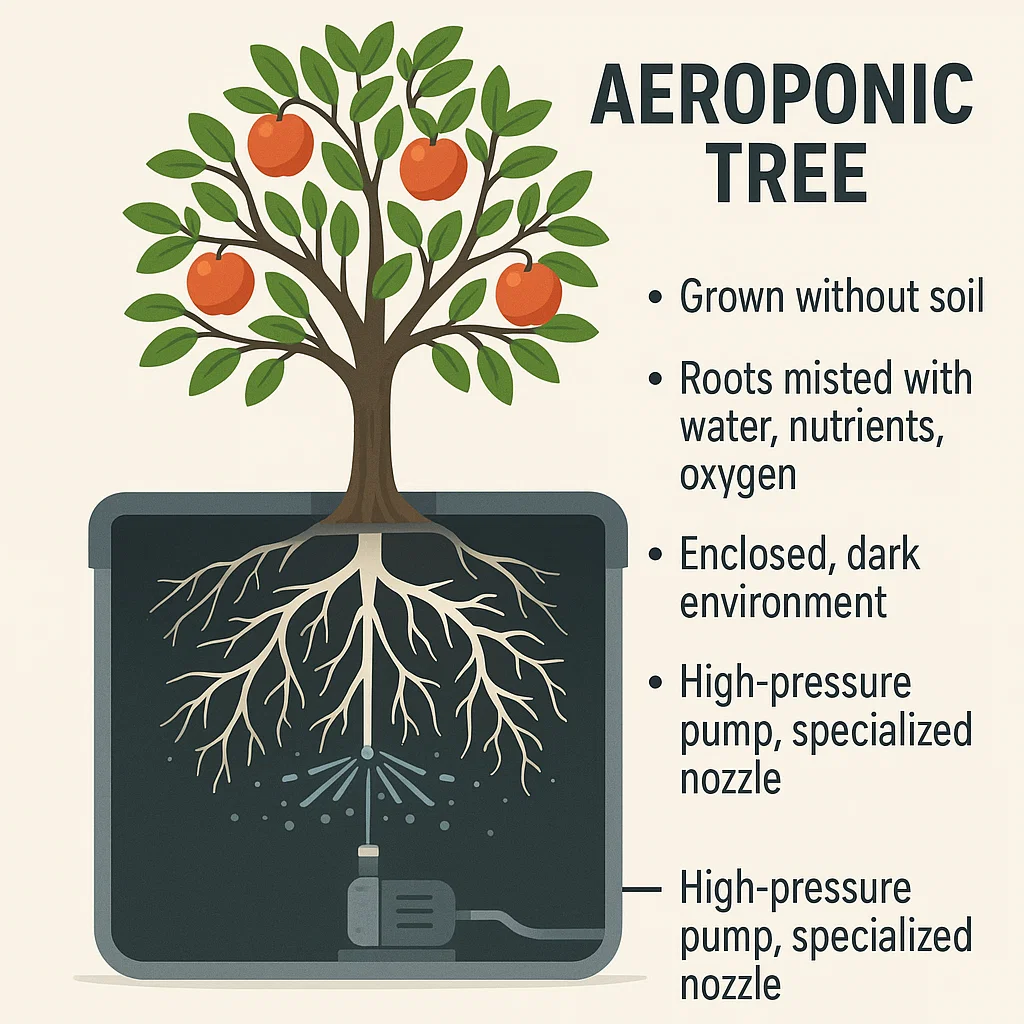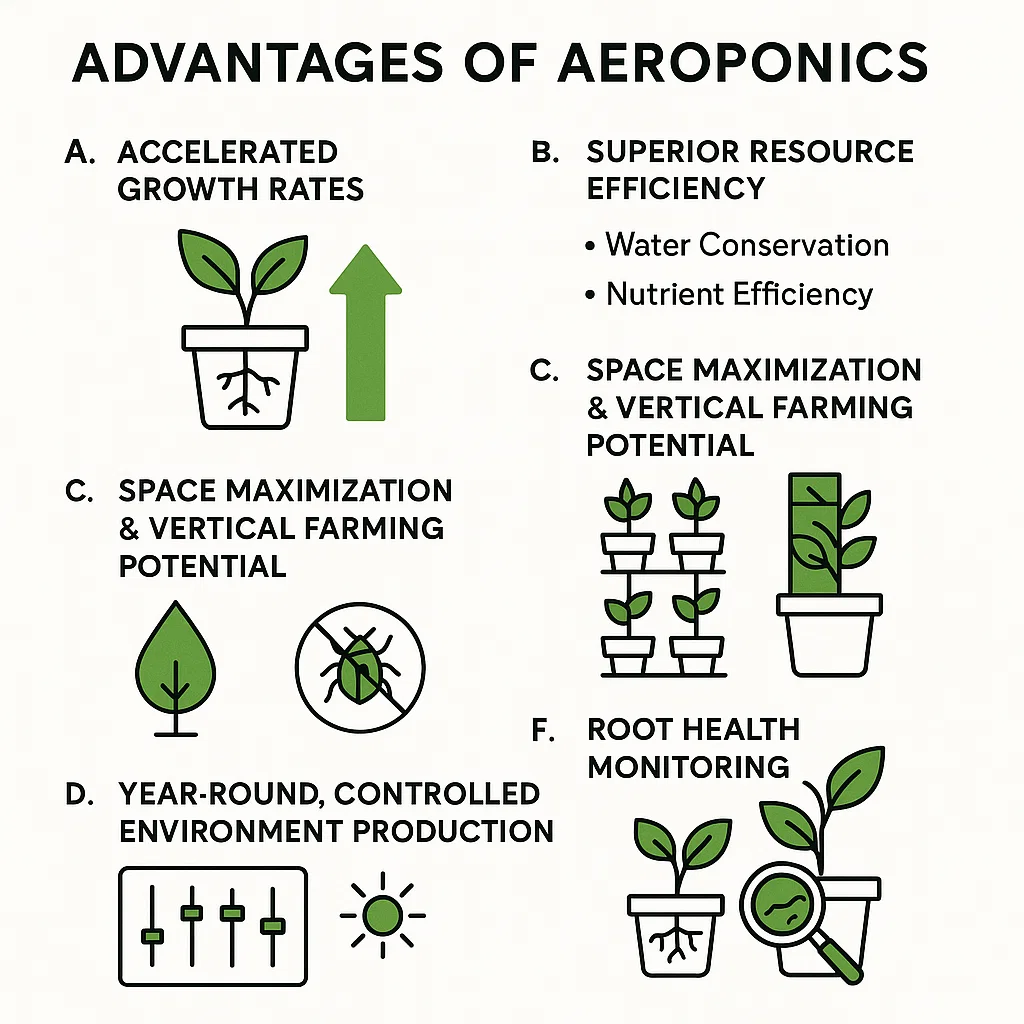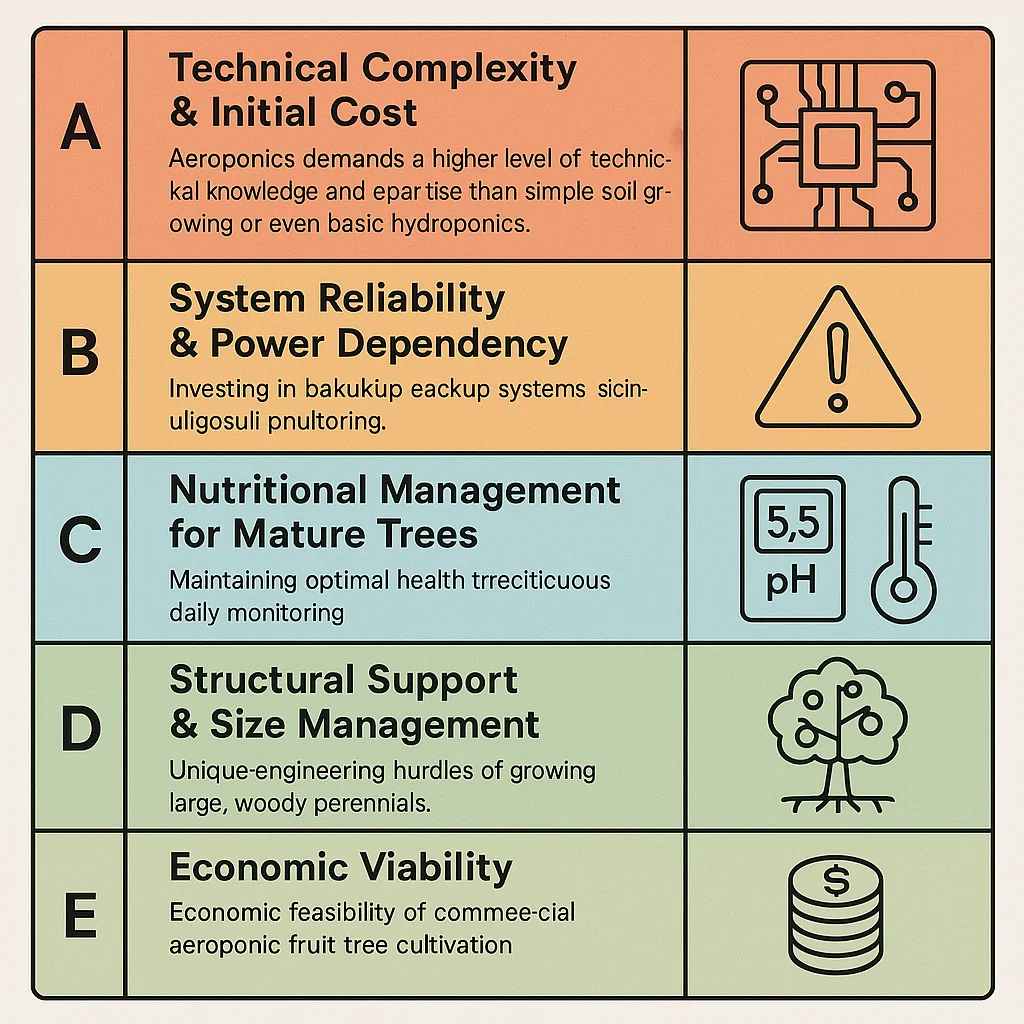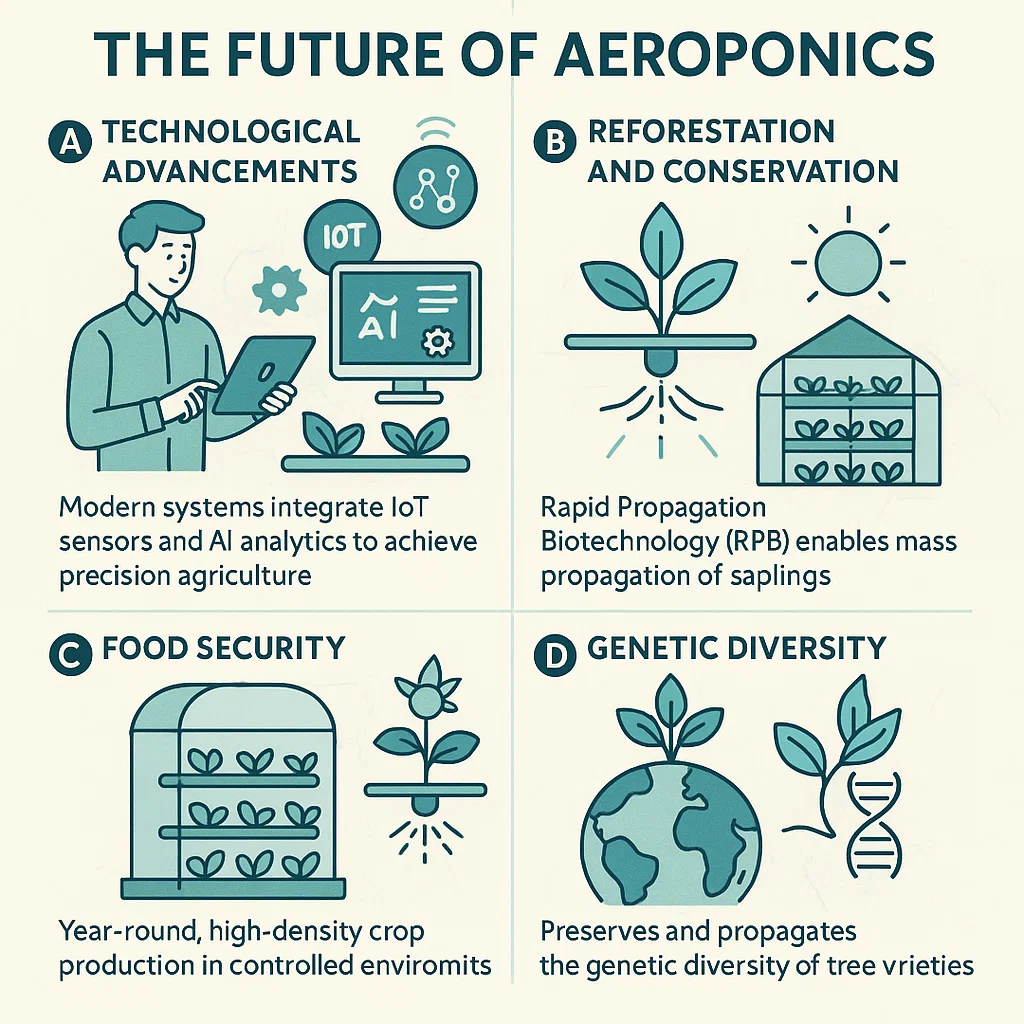The way we grow food is changing rapidly, driven by the need for efficiency, sustainability, and resilience against climate change. At the forefront of this agricultural revolution is a technology that completely removes soil from the equation, suspending the plant roots in the air: aeroponics.
While this technique has famously transformed the cultivation of lettuce and herbs, its application to larger, perennial species—specifically fruit trees—heralds a new era for horticulture, promising year-round harvests of premium, pesticide-free produce in urban environments across the globe.
Introduction to Aeroponic Trees
Aeroponics is a sophisticated soilless cultivation technique where plants are grown with their roots suspended in an enclosed, dark environment. The term itself is derived from the Greek word “aero” (air) and “ponos” (labor or work).
When applied to woody perennials, an aeroponic tree is a fruit-bearing (or ornamental) tree cultivated without any soil or growth media. Instead, its bare roots are periodically misted or fogged with a precise nutrient solution. This method is gaining immense popularity due to its ability to maximize plant growth with minimal use of water and land.
B. Core Concept: The core concept is elegant in its simplicity and profound in its results: delivering water, nutrients, and, crucially, oxygen directly to the root zone via an ultra-fine mist. Unlike soil, which can restrict gas exchange, the aeroponic chamber ensures that the roots receive ample amounts of oxygen for essential respiration. This constant, perfect balance of moisture, nutrients, and oxygen is key to stimulating rapid, healthy root development.
C. Hydroponics vs. Aeroponics for Perennials: Aeroponics is often regarded as the most advanced form of hydroponics. While both systems eliminate soil, they differ fundamentally in how they feed the roots. Traditional hydroponic methods, like Deep Water Culture (DWC) or Nutrient Film Technique (NFT), rely on submerging the roots in or running them through a water solution.
Aeroponics, specifically high-pressure aeroponics (HPA), uses specialized nozzles and high-pressure pumps to create an atomized mist with droplet sizes typically ranging between 20 to 50 microns. This mist provides a much greater surface area for nutrient and oxygen absorption compared to the water droplets from low-pressure systems. For larger, long-term crops like fruit trees, this superior oxygenation and controlled delivery is a massive advantage.
D. Potential & Vision: Urban orchards and genetic futures: The promise of aeroponics for fruit trees extends far beyond a hobby. It offers a vision for sustainable, high-density urban agriculture and year-round, reliable fruit production. It allows for complete independence from external weather, seasons, and soil-borne diseases. Furthermore, aeroponics is proving valuable as a tool for genetic preservation and Rapid Propagation Biotechnology (RPB), allowing scientists and growers to rapidly mass propagate plant material and clone rare or desired varieties efficiently.

How Aeroponics for Trees Works
Building an aeroponic system capable of supporting a woody perennial like a fruit tree requires specialized engineering, particularly using High-Pressure Aeroponics (HPA) technology.
A. Core System Components
Enclosed Reservoir and Chamber: The base of the system is the nutrient reservoir, which holds the water and nutrient solution. The root chamber, where the roots are suspended, must be dark and enclosed to prevent light from reaching the roots (which encourages algae growth) and to maintain the high humidity critical for root health. The reservoir often includes an air pump for pre-oxygenating the nutrient solution.
High-Pressure Pump & Misting Nozzles: These are the heart of the HPA system. The pump pressurizes the nutrient solution, forcing it through precision-engineered nozzles to create the ultra-fine fog or mist. This high-tech approach is what differentiates true aeroponics from simple drip or spray systems.
Support Structure: Unlike soil, which provides natural anchorage, an aeroponic tree requires external physical support. The trunk is supported where it enters the chamber, often using flexible rubber collars or net pots. For larger, heavy fruit trees, a supplementary supporting framework, such as a sturdy trellis or posts, becomes necessary to manage the canopy and fruit load.
Timer/Controller: Precision is everything in aeroponics. The system’s “brain” is the timer or controller that dictates the misting cycles. These intervals must be perfectly calibrated to ensure the roots remain moist and nutrient-fed, yet constantly exposed to air for maximum oxygen uptake.
B. The Process: From Cutting to Fruit
The life cycle of an aeroponic tree differs significantly from its soil-grown counterpart:
Seedling or Cloning: Trees are often started from cuttings (clones) because aeroponic cloning systems promote faster and healthier root growth than traditional methods. Aeroponics is the quickest possible way to take a seed or cutting to a fruiting plant.
Transplantation: The cutting or young sapling is transplanted, its roots bare and clean, into the collar or basket atop the root chamber.
Root Development in Mist: The roots dangle freely in the dark, high-humidity chamber. The pump cycles on for short bursts—typically under 5 seconds for young plants, repeating every 5 minutes. For rooted plants, cycles may be longer (e.g., 20 seconds on) with longer off periods (e.g., 8 to 20 minutes), as the bare root structures act as moisture reservoirs.
Vegetative Growth, Flowering, and Fruiting: As the tree matures, environmental controls (light, temperature, nutrients) are adjusted to maximize vegetative growth, followed by cues to initiate flowering and subsequent fruiting, which can lead to a shorter overall growth cycle.
Advantages of Growing Trees Aeroponically
The shift to aeroponic cultivation for woody species yields substantial benefits, providing a compelling case for its role in future food systems.
A. Accelerated Growth Rates: In the ideal, oxygen-saturated environment of the aeroponic chamber, plants do not need to expend energy searching for water or nutrients. This saved energy is redirected entirely into vegetative growth, resulting in significantly accelerated development.
Studies suggest that aeroponic techniques can shorten a plant’s overall growth cycle by approximately 25%.
For fruit trees, this translates to faster maturation and potentially earlier fruiting.
B. Superior Resource Efficiency: Aeroponics is the champion of resource efficiency, addressing critical issues like water scarcity.
Water Conservation: Because the system recirculates the nutrient mist, water usage is dramatically reduced. Vertical farming techniques incorporating aeroponics can reduce water usage by up to 90% compared to conventional farming. In fact, systems using misting and recapture can cut water usage by up to 95%.
Nutrient Efficiency: Nutrients are delivered precisely where they are needed—directly to the root surface. This efficiency minimizes waste, with the aeroponic system demonstrating a fertilizer use efficiency that is 1.73 times greater than conventional soil systems in research settings.
C. Space Maximization & Vertical Farming Potential: Aeroponics allows for high-density planting and is integral to the structure of modern vertical farms. By stacking plants in layers or towers, indoor farms can utilize vertical space, allowing them to produce up to 10 times more yield per square foot of land than traditional farming methods. This capability is revolutionary for urban areas where space is limited and demand for local produce is high.
D. Purity and Pest/Disease Reduction: By eliminating soil—the main platform for pests and infections—aeroponic systems dramatically reduce the risk of soil-borne pathogens and pests. This enclosed root environment means that crops are cleaner, require no pesticide application, and have a reduced risk of disease or infestation.
E. Year-Round, Controlled Environment Production: One of the greatest advantages is climate independence. Aeroponic production occurs in a controlled microclimate where light, temperature, humidity, and airflow are all managed. This enables continuous, year-round crop production regardless of external weather conditions or seasons, ensuring a stable and reliable food supply.

F. Root Health Monitoring: Aeroponics allows for continuous access to the entire root system throughout the plant’s life. This feature is invaluable for research, allowing scientists to monitor nutrient and water uptake in real-time. For the commercial grower, it allows for immediate visual inspection and rapid intervention if any issue (like root disease or nutrient deficiency) arises.
Challenges and Considerations
While aeroponics offers extraordinary potential, especially for woody crops, it is not without significant complexities that growers must address.
A. Technical Complexity & Initial Cost: Aeroponics requires a higher level of technical knowledge and expertise than simple soil growing or even basic hydroponics (like DWC). The initial setup costs are high, driven by the need for high-pressure pumps, specialty misting nozzles, and the control systems that manage them.
B. System Reliability & Power Dependency: The fine-mist delivery system is highly efficient but critically vulnerable. Because the roots rely on the precise, brief misting cycles, a pump failure or a power outage can cause the roots to dry out very quickly—potentially leading to plant death in a matter of hours. Therefore, investing in quality equipment and implementing backup systems, such as large batteries or standby generators, is essential for continuous operation and protection.
C. Nutritional Management for Mature Trees: Maintaining optimal health requires meticulous daily monitoring.
pH and EC Control: The acidity (pH) and nutrient concentration (Electrical Conductivity or EC) of the solution must be precisely managed, as these factors directly impact nutrient availability and absorption. The ideal pH for nutrient solutions in soilless culture is often maintained at 5.5, aiming for a root environment pH between 6.0 and 6.5.
Temperature Stability: Water temperature is critical. If the reservoir water gets too warm (ideally kept between 18–23°C), it holds less dissolved oxygen, which can cause root stress and encourage pathogen growth (e.g., root rot).
Clogging: The microscopic holes in the misting nozzles are susceptible to clogging from the salts and compounds found in nutrient solutions. Regular sanitation and maintenance are required to ensure continuous mist delivery.

D. Structural Support & Size Management: Growing large, woody perennials presents unique engineering hurdles. Fruit trees naturally develop massive root systems for anchoring and resource acquisition, which can physically consume the misters in an aeroponic chamber.
Growers must manage the massive root ball through root pruning to prevent clogging and to keep the plants productive. Additionally, the canopy and fruit load of a mature tree, even a dwarf variety, must be actively supported using trellising or caging systems.
E. Economic Viability: The economic feasibility of commercial aeroponic fruit tree cultivation depends on startup costs versus the value and speed of the yield. While upfront investment is high , the capacity for high-density planting (vertical integration) and year-round production can potentially offset these costs over time, creating a lucrative opportunity for market growth.
Best Tree Varieties for Aeroponics
Aeroponics is highly adaptable, but success with trees relies heavily on selecting species and rootstocks designed for controlled, compact environments.
A. Dwarf and Genetic Dwarf Rootstocks: The most critical factor is size management. Commercial fruit trees are typically grafted, consisting of a fruiting variety (scion) and a rootstock that controls the tree’s size. Choosing a dwarfing rootstock is essential for aeroponics because these genetics naturally promote flowering and fruiting rather than excessive vegetative growth. Dwarfing rootstocks like the Geneva series (G.11, G.41) for apples or specific dwarfing rootstocks for citrus (e.g., F&A 418 for ‘Navelina’ or ‘Flying Dragon’ for lemon) are preferred.
B. Top Fruit Tree Candidates
Citrus Trees: Dwarf varieties of lemons and limes are excellent candidates. For example, the ‘Eureka’ lemon is sensitive to low temperatures, making the controlled environment of aeroponics ideal for cultivation.
Fig Trees: Figs are known for their adaptability to container and controlled environments, making them a suitable option for experimental hydroponic and aeroponic setups.
Dwarf Stone Fruit Trees: Dwarf peaches, such as ‘Elberta,’ ‘Contender’, and ‘Harvester’ varieties, are readily available and popular for indoor gardening, adapting well to size constraints.
Pomegranate: These trees are relatively hardy and can be managed effectively in a controlled setting.
Dwarf Pears: Dwarf varieties like ‘Bartlett’ and ‘Anjou’ are also suitable for the size restrictions of a controlled system.
C. Ornamental & Specialty Trees: Beyond edible fruits, aeroponics is a highly feasible method for rapid, large-scale plant production, including nursery seedlings. It is also employed as a research tool for genetic conservation and the propagation of rare or specialty arboreal species.
Getting Started: A Practical Guide
Setting up a functional aeroponic system for trees requires careful planning and specialized inputs.
A. Choosing a System: Systems range from small, entry-level hobbyist setups costing around $339 to commercial, high-density towers. A commercial tower supporting 44 plants might cost approximately $600. Commercial-grade High-Pressure Aeroponics (HPA) systems are often necessary to achieve the fine mist required for the best root development.
B. Sourcing Plants; Growers should start with clean, disease-free cuttings or young saplings. Aeroponics is highly efficient for cloning, which involves taking cuttings and suspending them in the chamber to promote faster root development than traditional soil or water propagation.
C. The Nutrient Solution: Specialized NPK for Fruiting
The NPK (Nitrogen-Phosphorus-Potassium) ratio must be adjusted as the tree moves through its life stages.
Vegetative Stage: Young trees require higher nitrogen (N) to support healthy vegetative growth, foliage, and stem production. Balanced ratios like 10-10-10 are suitable for young citrus to ensure steady development.
Flowering/Fruiting Stage: Once the tree is mature, the formula must shift. Nitrogen should be decreased, while Phosphorus (P) and Potassium (K) are increased. High P is essential for flower formation, and high K is critical for improving fruit size and quality.
Ratios like 8-8-16 or 6-12-12 are preferable for fruiting citrus.
During fruit development and ripening, very high potassium formulas (e.g., 0-5-65) can be used to enhance fruit firmness.
Micronutrients: In addition to NPK, essential micronutrients (like iron, zinc, manganese, boron, and copper) must be included, as fruit trees are known to be sensitive to deficiencies in these areas.
D. Environmental Control: Controlling the environment is non-negotiable for success:
pH and EC: Monitor the pH daily and maintain it ideally around 5.5 to ensure maximum nutrient availability. The Electrical Conductivity (EC), which measures nutrient concentration, should be monitored and maintained within species-specific ranges (e.g., 1.6–2.4 for many fruiting crops).
Temperature: Maintain the root zone temperature between 18–23°C (64–73°F) to maximize dissolved oxygen content and prevent root diseases.
Light: As the system operates indoors, high-intensity grow lights must be used to meet the high daily light integral (DLI) requirements of a fruiting tree.
E. Training and Pruning: Pruning is essential for indoor, soilless fruit trees. The goals of pruning are to improve light penetration, maintain a simple branch structure, and manage crop load (fruit thinning) to prevent the tree from producing too many small fruits. Techniques like espalier (training branches flat) or using vertical trellises and cages can help manage the canopy size and provide structural support.
F. Monitoring and Maintenance: A daily or weekly checklist is necessary to prevent system failure :
pH/EC Check: Test and adjust the nutrient solution daily.
Nozzle Inspection: Check misting nozzles regularly for salt buildup or clogs. A quick rub with isopropyl alcohol is often enough to clear the small orifices.
Root Health: Inspect the roots for any signs of root rot or dryness. Root trimming is a beneficial practice for perennial species to manage the massive root ball and maintain the system’s function.
Case Studies and Real-World Applications
The technology behind aeroponic trees has evolved from specialized research to viable commercial agriculture.
A. NASA and Space Research: The initial concepts for aeroponics were pioneered by NASA as a tool for studying plant root physiology and developing Controlled Ecological Life Support Systems (CELSS) for space exploration. Aeroponics provides the unique ability to continuously monitor root and nutrient uptake by the whole plant, making it an invaluable research tool.
B. Commercial Vertical Farms: The commercial viability of aeroponics is accelerating. The global aeroponics market was valued at $2,391.75 million in 2024 and is projected to exhibit robust growth, reaching $5,652.37 million by 2032. While the initial focus was on high-turnover leafy greens, major vertical farm operators like AeroFarms are expanding their crop portfolio to include berries and tomatoes. The success in high-density, controlled cultivation proves the economic potential, driving the expansion of small-scale indoor farming technology.
C. Research Institutions: Universities and research facilities worldwide are actively studying aeroponics for arboreal species. Research has been conducted on the long-term cultivation of woody plants like C. arabica (coffee) and the effects of nutrient solution pH on the root architecture of apple rootstocks.
The Future of Aeroponic Trees
Aeroponics represents a significant leap forward in agriculture, with its future inextricably linked to sophisticated technology and the growing global need for sustainable food.
A. Technological Advancements: The next generation of aeroponic systems is powered by digital intelligence. Modern systems integrate IoT (Internet of Things) sensors and AI (Artificial Intelligence) analytics to achieve precision agriculture.
AI models process real-time data on humidity, temperature, nutrient concentration, and root health to predict outcomes, automate misting cycles, and precisely regulate fertilizer concentrations. This shift is giving growers the tools to make better, faster, and more profitable decisions by optimizing resource efficiency and yield at scale.
B. Reforestation and Conservation: Aeroponics offers potential beyond food production, specifically in conservation and ecological efforts. Rapid Propagation Biotechnology (RPB), which uses sterile, controlled aeroponic conditions, allows for the mass propagation and cloning of rare or threatened plant material, including woody saplings, for reforestation and genetic preservation projects.
C. Food Security: The role of aeroponics in achieving food security is undeniable. By enabling year-round, high-density production in controlled environments, this technology addresses major global challenges, including land scarcity, water inefficiency, and climate disruption. It provides a pathway to create resilient local food systems, supplying fresh, high-quality, and nutrient-dense produce—free of chemicals—to urban and arid areas.
D. Genetic Diversity: As a highly feasible method for large-scale plant production and disease-free plant propagation , aeroponics is crucial for preserving and propagating the genetic diversity of tree varieties, ensuring the long-term health and resilience of our global food supply.

Frequently Asked Questions (FAQs) and Concepts
What is Aeroponics?
A soilless cultivation method where plant roots are suspended in air and misted with a nutrient solution.
What is Dwarf Rootstock?
The root system of a grafted fruit tree that genetically controls the above-ground tree size, keeping it small and ideal for controlled environments.
What is Electrical Conductivity (EC)?
A measurement indicating the total concentration of dissolved mineral salts (nutrients) in the water solution.
What is High-Pressure Aeroponics (HPA)?
An advanced system using high-pressure pumps and specialized nozzles to create an ultra-fine, highly oxygenated mist (20–50 microns).
What is Hydroponics?
A broad term for soilless growing techniques where plant roots are grown in nutrient-rich water, differing from aeroponics where roots are suspended in air.
What is Misting Cycle?
The precise on/off intervals (controlled by a timer) during which the roots are sprayed with the nutrient mist.
What is Nutrient Solution?
Water mixed with essential macronutrients (NPK) and micronutrients, used to feed the plants in soilless systems.
What is pH?
A measure of the acidity or alkalinity of the nutrient solution, which dictates how easily plants can absorb specific nutrients.
What is Root Zone?
The environment where the roots are housed (in aeroponics, this is the dark, enclosed aeroponic chamber














